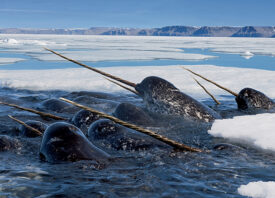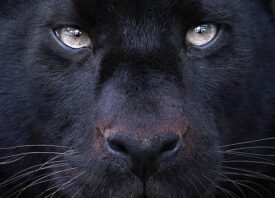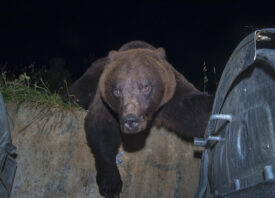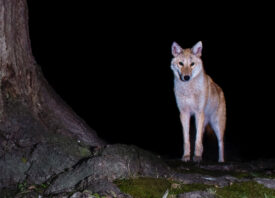Search this site
Unflinching Photojournalism from Wildlife Photographer of the Year 2020

“Having convinced the trader that he was interested in buying the monkey, Paul photographed it in the dark backroom using a slow exposure. Much of the illegal wildlife in the open-air bird market is traded in the backroom areas. Macaques can be legally sold; banned species such as baby orangutans are kept boxed out of sight. Such animal markets facilitate the international illegal trade, supplying on demand what isn’t in stock. So many animals stacked so close together also facilitates the spread of disease.” Photo: Paul Hilton / Wildlife Photographer of the Year
In his natural rainforest habitat, this young macaque would have lived in a large group with other animals. By the time the photojournalist and wildlife trade consultant Paul Hilton found him, he was alone, tied to a cage at an animal market in Indonesia. His parents would have been killed, and after this photo was made, the orphaned animal would have been sold, perhaps as a pet, to a zoo, to be eaten, or to be used in biomedical research.
Early this year, after following news of the coronavirus outbreak, and recognizing the connection between the global wildlife trade and future pandemic threats, Hilton shared this photograph along with an urgent question: “When will it end?” Days later, China’s top legislature banned the trade of wildlife for consumption, though exemptions exist for non-food products, including research, fur, and medicinal uses and conservationists warn violations are widespread.
Wildlife Photographer of the Year, the annual award produced by the Natural History Museum in London, has been a fixture of the photography world since 1965, but this year might be the most important in history, with Hilton’s photograph taking home the prize for the Wildlife Photojournalist Story Award. In many ways, the award’s photojournalism category stands out, serving as an urgent cry for action and highlighting the disastrous consequences of exploiting animals and the natural world.
In 2020, the death toll for the novel coronavirus surpassed one million, sparking overdue conversations about the rise in zoonotic diseases and the dangers of global wildlife trade, the exploitation of animals, and the degradation of the natural environment. Wildlife trafficking is now the second biggest threat to species, following habitat destruction.
Wildlife Photographer of the Year has never shied away from painful images that highlight our precarious relationship with the natural world. In previous years, the Natural History Museum has awarded some of the most important work of photojournalists on the frontlines of the wildlife trade, including images of screaming macaques being used for street shows, the fins of 30,000 sharks killed for shark fin soup, and 4,000 frozen, trafficked pangolins.

“But for the visitors to the travelling Russian circus – here in the city of Kazan, Tatarstan – it is entertainment. They are ignorant of how the polar bear has been trained and what it might endure behind the scenes – including the fact that, when not performing, it probably spends most of its time in a transportation cage. The polar bear is one of four females, reportedly captured in Russia’s Franz Josef Land when two years old (‘abandoned’, according to the trainer) and still performing 18 years later – valuable property for the Circus on Ice, the only circus known to own polar bears. For the photographer, who has spent a couple of years reporting on animal exploitation and abuse, this was the most symbolically shocking of all the scenes of exploitation she has shot, featuring as it does such an Arctic icon of wildness.” Photo: Kirsten Luce / Wildlife Photographer of the Year
This year, the Single Image winner for Wildlife Photojournalism is Kirsten Luce‘s documentation of what is believed to be the world’s only circus act with performing polar bears, where the bears are fitted with metal muzzles and the trainer holds a metal rod. “Though controversial, it is not illegal in Russia for these bears to perform,” Luce says. “Polar bears are a threatened species and are often used as a symbol for conservation.” The image was part of a National Geographic story on wildlife tourism and the unseen suffering animals endure as part of attractions around the world.
Wildlife Photographer of the Year is developed and produced by the Natural History Museum, London. The exhibition is open now through June 5th, 2021. Below, you’ll find the stories behind just a few of this year’s Highly Commended images. During this moment of environmental (and human) crisis, these visceral, often challenging photos can take on new and transformative power, highlighting recent tragedies and inspiring long-term change.
We encourage you to explore the other categories as well; check out all the winning images here. Wildlife Photographer of the Year is now open for entries for next year’s competition. The deadline to enter is Thursday, December 10th.

“This is Tomohon Market in northern Sulawesi, Indonesia. Local hunters and traders bring wild mammals and reptiles for sale here, along with domestic cats and dogs–some dead, others alive, to be killed and butchered on site. Quentin observed the reality of the bushmeat trade, with wild animals in poor condition kept alive, tied to ropes or piled up in cages, awaiting butchery. He was struck by the juxtaposition of contrasting economies: the name-brand clothes of the stallholders amid the wild-animal body parts.
“The variety of bushmeat on sale here –which at one time included that of endangered primates –has put Tomohon, billed as an ‘extreme’ food market, on the tourist trail. Since the arrival of Covid-19, suspected to have originated in a food market in China, there have been calls to ban the sale and butchery of live wild animals in Indonesia. Where many different species are confined together in inhumane and unhygienic conditions and then butchered on the same surfaces, there is a perfect opportunity for viruses to cross species barriers. But being informal, such markets are difficult to regulate.
“The United Nations has, however, warned that most emerging infectious diseases originate from the wild and that ‘as we continue to relentlessly encroach on nature and degrade ecosystems, we endanger human health’. At the very least, scientists are calling for the separation of wild animals from farmed animals in markets, together with a crackdown on the massive worldwide illegal trade in wildlife.” Photo: Quentin Martinez / Wildlife Photographer of the Year

“To convey the scale of the operations, Garth chartered a plane and flew over the desolate landscape, choosing the early evening light for contrast and mood. The trucks in the foreground are the height of a two-storey house but are dwarfed by the giant open pit behind. The terraced strips lead towards a refinery –fronted by enormous yellow sulphur piles–and the Athabasca River beyond. All around the pit are tailings waste ponds, which contain a slurry so toxic that birds have to be prevented from landing on them. Currently, most of the bitumen is shipped, diluted, by pipeline to refineries in the US for processing.
“The environmental impact of the whole operation is three-fold. First, the mines are created by clearing boreal forest, a rich ecosystem and a vitally important terrestrial carbon sink. Second, the process of extracting the low-grade oil is hugely energy intensive and, according to the region’s First Nation indigenous people, continues to pollute. Third, fully exploiting this massive emissions-intensive fuel source will result in the further release of huge amounts of carbon that will, say climate scientists, contribute disproportionately to global emissions and make it impossible to keep under the 2°C global warming threshold and avoid catastrophic climate change.” Photo: Garth Lenz / Wildlife Photographer of the Year

“The fire would have been started deliberately to clear a logged area of secondary forest for agriculture or cattle farming. In 2015, more than half the state’s primary forest was destroyed by fires started by illegal logging on indigenous land. Burning has continued in the state, exacerbated by drought, as land has been cleared, legally and illegally. In the past year, invasion of indigenous reserves and conservation areas by loggers and land-grabbing ranchers has increased, emboldened by President Jair Bolsonaro’s commitment to open up the Amazon for business and his attacks on indigenous groups.
“The group most imperilled in the state are the Awá. Just a few hundred Awá remain ‘in a pocket of forest amid devastation’, says Charlie. Deforestation doesn’t just cause destruction of biodiversity and the loss of the livelihoods of the people who depend on it. Burning trees means losing their oxygen output and letting back into the atmosphere the carbon they have sequestered. Then cattle brought onto the cleared land add to the greenhouse gases. In 2020, there have been record levels of deforestation in the Amazon, with illegal loggers emboldened by a lack of law enforcement and with cattle ranching fuelled by the global demand for beef.” Photo: Charlie Hamilton James / Wildlife Photographer of the Year

“A boat’s main line can extend for more than 80 kilometres (50 miles), with thousands of baited hooks. When small seabirds dive down and bring the baited hooks to the surface, petrels and albatrosses try to swipe their catches whole, hook themselves, and drown.
“In recent years, more seabird-friendly fishing practices–setting lines after dark, using weighted hooks that sink more quickly, dragging bird-scaring lines –have dramatically reduced the annual bird bycatch off South Africa, now numbering in the hundreds instead of tens of thousands. But worldwide, every year, more than 300,000 seabirds, including 100,000 albatrosses, are still killed elsewhere by longlines alone.” Photo: Thomas P Peschak / Wildlife Photographer of the Year



